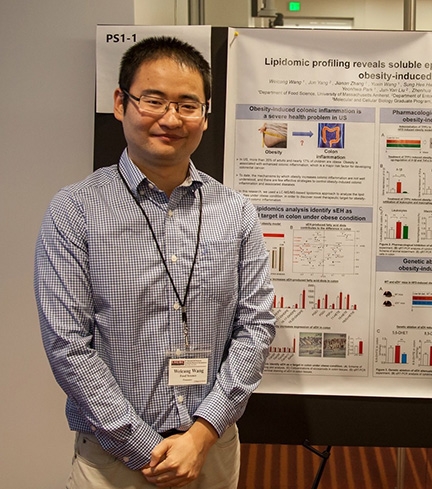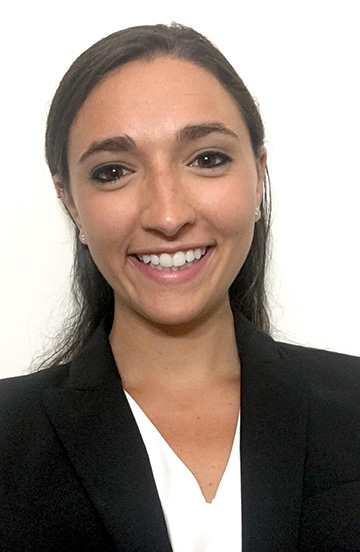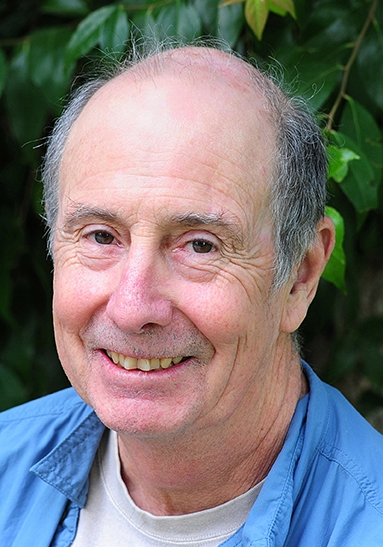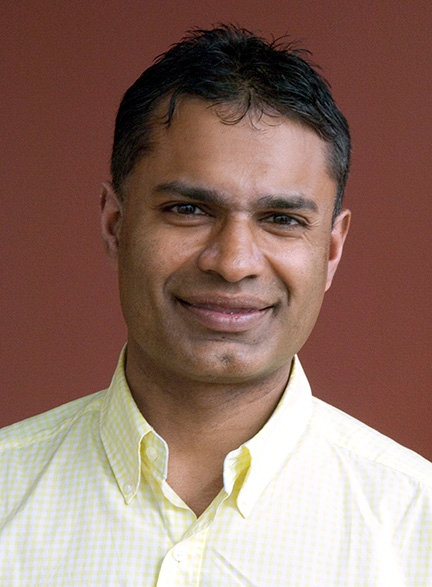- Author: Kathy Keatley Garvey

Researchers from Harvard Medical School and the University of California, Davis, blocked the progression of cancer growth caused by environmental carcinogens and food contaminants by resolving an eicosanoid/cytokine storm triggered by cell debris.
The research, from the laboratories of physician-researcher Dipak Panigrahy of Harvard Medical School and UC Davis distinguished professor Bruce Hammock, is published in the current edition of the Proceedings of the National Academy of Sciences.
“We advanced the hypothesis that cell debris from chemotherapy, resection of tumors and even immunotherapy can make these therapies a double-edged sword stimulating cancer growth and metastasis while treating it,” said Hammock, who holds a joint appointment in the UC Davis Department of Entomology and Nematology and the UC Davis Comprehensive Cancer Center.
In their paper, “Resolution of Eicosanoid/Cytokine Storm Prevents Carcinogen and Inflammation-Initiated Hepatocellular Cancer Progression,” the scientists covered the potent environmental carcinogen and food contaminant aflatoxin. Aflatoxins are toxins produced by certain fungi that are found in such agricultural crops as corn, peanuts, cottonseed, and nuts.
“Not only is this fungal metabolite genotoxic but it is also a tumor promoter,” said Hammock, defining a genotoxic agent as “a chemical that damages cellular DNA, resulting in mutations or cancer.”

Lead authors Anna Fishbein of Harvard University, a recently enrolled medical student in the Georgetown University School of Medicine, and Weicang Wang, a postdoctoral scholar in the Hammock lab, said aflatoxin exerts some of its cancer-promoting effects by generating cell debris which activate a pathway leading to eicosanoid and cytokine storms. These two classes of natural chemical mediators, they explained, control many of our defenses against pathogens, but when out of control, these storms lead to growth and metastasis of liver cancer.
“We demonstrated that debris generated by aflatoxin B1accelerates tumor dormancy escape in liver cancer models by stimulating a macrophage-derived eicosanoid and cytokine storm of pro-inflammatory mediators,” said Fishbein. “Thus, targeting a single inflammatory mediator or eicosanoid pathway is unlikely to prevent carcinogen-induced tumor progression.”
The researchers showed that the inhibition of the soluble epoxide hydrolase (sEH) pathway or the combined inhibition sEH and cyclooxygenase-2 (COX-2) pathways prevented the carcinogen debris-induced storm of both cytokines and lipid mediators by macrophages--specialized detect-and-destroy cells.
In animal models, the dual COX-2/sEH inhibitor PTUPB prevented the onset of debris-stimulated liver cancer. The dual inhibition of COX-2/sEH pathways may be “a novel approach” to control cancer of the liver, the researchers said.

“We also showed that carcinogen-generated debris stimulates an endoplasmic reticulum (ER) stress response which may promote HCC progression. Importantly, PTUPB prevents the ER stress response,” Wang added. “We created a novel model of debris-stimulated liver cancer designed to study new strategies for the prevention and treatment of carcinogen-induced cancers with tremendous potential to translate to the clinic.”
From a nutritional standpoint, aflatoxin is a common food contaminant, Wang said. “But good agricultural practice and post-harvest technology keep the levels very low. However, in much of the world, aflatoxin levels are so high that many crops are discarded. In other cases, these contaminated grain and nut crops enter the human food chain, where they cause acute toxicity, severe anemia and of course later lead to cancer.”
UC Davis co-author and nutritional scientist Yuxin Wang (who is the wife of Weicang Wang) said that “finding a way to modulate the events that lead to the eicosanoid storm would have a major effect on children's health in many developing countries.”

Fishbein and Allison Gartung of the Panigrahy lab not only used the soluble epoxide hydrolase inhibitors from the Hammock lab but also used some prototype drugs synthesized by chemist Sung Hee Hwang of the UC Davis School of Veterinary Medicine “which proved to be even better,” Hammock said.
“These compounds are a synthetic combination of cyclooxygenase inhibitors like celebrex with epoxide hydrolase inhibitors,” Hammock said. “Since epoxide hydrolase inhibitors stabilize the endoplasmic reticulium stress response and transcriptionally down regulate inflammatory cyclooxygenase we expected them to synergize with cyclooxygenase inhibitors. We were surprised and pleased with the dramatic interaction of these inhibitors when combined in the same molecule in reducing the cytokine and eicosanoid production by in response to cell debris.”
“The observations from Harvard show that by inhibiting soluble epoxide hydrolase, we can block the activation of these inflammatory cascades leading to tumor promotion, growth and metastasis,” Hammock said. “We have a compound in human clinical trials that inhibits sEH, which should be clinically available in a few years. In addition. we have found natural inhibitors of the epoxide hydrolase in a variety of plants, including crop plants. This may allow us to reduce the cancer risk and block the gastrointestional erosion and bleeding caused by dietary aflatoxin using natural means.”
Other members of the 15-member team are UC Davis researchers Jun Yang, Yuxin Wang and Sung Hee Hwang; Harvard researchers Haixia Yang, Victoria Hallisey, Jianjun Deng, Sanne Verheul, Allison Gartung, Diane Bielenberg and Mark Kiernan (now of Bristol-Myers Squibb); and Sui Huang, Institute for Systems Biology, Seattle. Hammock and Panigrahy are the corresponding authors.
The research drew strong financial support as the Panigrahy's laboratory is generously supported by the Credit Unions Kids at Heart Team, the CJ Buckley Pediatric Brain Tumor Fund, and the Joe Andruzzi Foundation; and Hammock's UC Davis grants from the National Institute of Environmental Health (NIEHS) Superfund Research Program, and the NIEHS RIVER Award (Revolutionizing Innovative, Visionary, Environmental Health Research).
Hammock, a member of the UC Davis faculty since 1980, has directed the UC Davis Superfund Research Program for nearly four decades. It supports scores of pre- and postdoctoral scholars in interdisciplinary research in five different colleges and graduate groups on campus. Last year Hammock received a $6 million, eight-year “Outstanding Investigator” federal grant for his innovative and visionary environmental health research: The award is part of the Revolutionizing Innovative, Visionary Environmental Health Research (RIVER) Program of NIEHS.
The abstract:
“Toxic environmental carcinogens promote cancer via genotoxic and nongenotoxic pathways, but nongenetic mechanisms remain poorly characterized. Carcinogen-induced apoptosis may trigger escape from dormancy of microtumors by interfering with inflammation resolution and triggering an endoplasmic reticulum (ER) stress response. While eicosanoid and cytokine storms are well-characterized in infection and inflammation, they are poorly characterized in cancer. Here, we demonstrate that carcinogens, such as aflatoxin B1 (AFB1), induce apoptotic cell death and the resulting cell debris stimulates hepatocellular carcinoma (HCC) tumor growth via an ‘eicosanoid and cytokine storm.' AFB1-generated debris up-regulates cyclooxygenase-2 (COX-2), soluble epoxide hydrolase (sEH), ER stress-response genes including BiP, CHOP, and PDI in macrophages. Thus, selective cytokine or eicosanoid blockade is unlikely to prevent carcinogen-induced cancer progression. Pharmacological abrogation of both the COX-2 and sEH pathways by PTUPB prevented the debris-stimulated eicosanoid and cyto- kine storm, down-regulated ER stress genes, and promoted macrophage phagocytosis of debris, resulting in suppression of HCC tumor growth. Thus, inflammation resolution via dual COX-2/sEH inhibition is an approach to prevent carcinogen-induced cancer.”


